This week, I show my latest finished painting and talk about Monet and the hall of fame – no! – the box of shame!
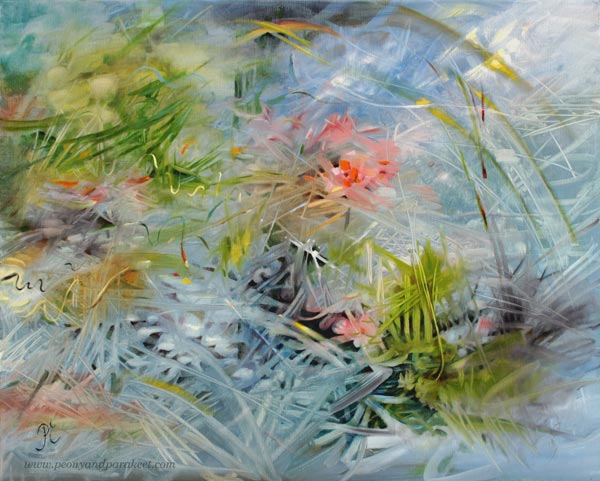
Last week, I participated in an online event organized by the Finnish Illustration Association. One of the speakers was Eeva Kolu, who talked about maintaining balance in life, not letting work take over all of it. She referred to a book that she had written which is unfortunately available only in Finnish. It’s called “Korkeintaan vähän väsynyt” (free translation: A Little Tired At Most)
I have been listening to the book on daily walks, and even if I am not finished yet, I already like the inner dialog that it raises. It makes me stop to ponder, sometimes agree, other times disagree. It’s not only pleasant, and yet, it’s definitely worth reading. One of the things Eeva Kolu brings up is shame. She says that shame defines the size of the box where we live. The box can become so small there’s not much room for life.
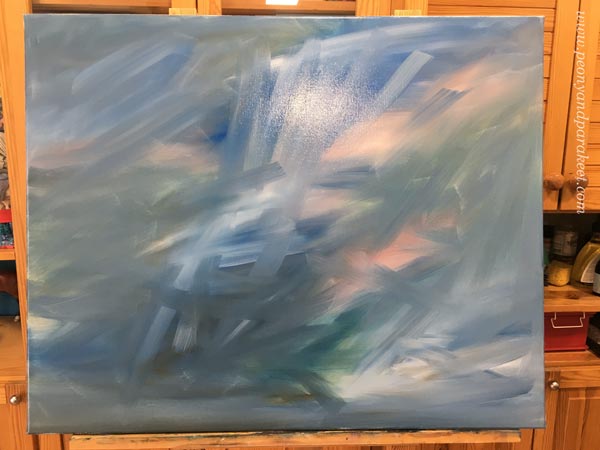
Eeva Kolu made me think about all the things I am shame of. Surprisingly, one of them is central to my art.
My Relationship With Old Art
When I was in my twenties and thirties, all I wanted to see was contemporary abstract art. In museums, I rushed through the old paintings because representational and traditional art was for mediocre people, and I didn’t want to be one of them. I felt shame about my uneducated family and the lack of abstract thinking in the surroundings where I came from. I had a new life with higher education, and my love for mathematics was well aligned with geometric shapes and lines.
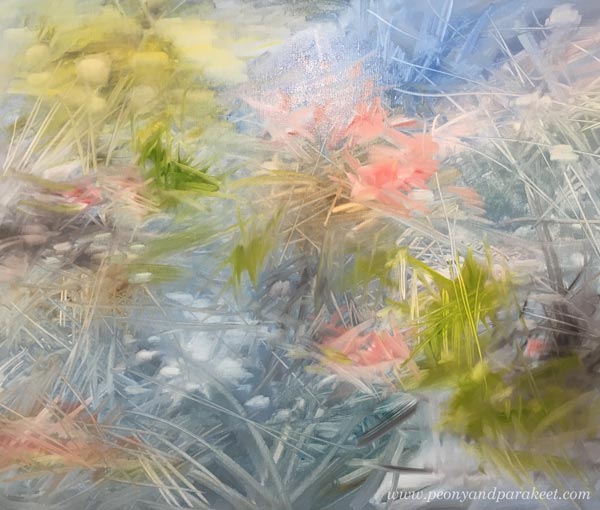
But age has made me understand more about my background and art as well. I have begun to love old art, and still, it’s something that causes me shame as well.
“Waterlilies,” my husband said when he saw this painting.
It made my box shrink. My intention was not to do any Monet. I just painted the dreamy blue that needed to come out, not make any imitation of anything.
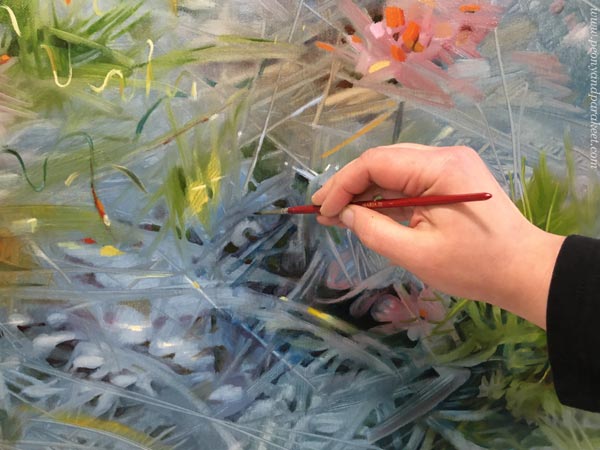
I Kind of Hate Monet’s Waterlilies
I have seen them in National Gallery in London. They are captivating. People love them.
But instead of making what people easily love, I would like to be an artist who sees to the future. Who builds paintings that are like complex machines. I should be a Leonardo of this age, imagining something technical that engineers will skillfully implement someday.
But my art has a mind of its own. No, a mind of mine. Or would I dare to say: a mind of my shame. I am stuck to the past, so I paint the past. I reach the worlds that feel excitingly unknown first but turn out familiar once the painting is finished. I end up recreating instead of inventing. That’s my shame.
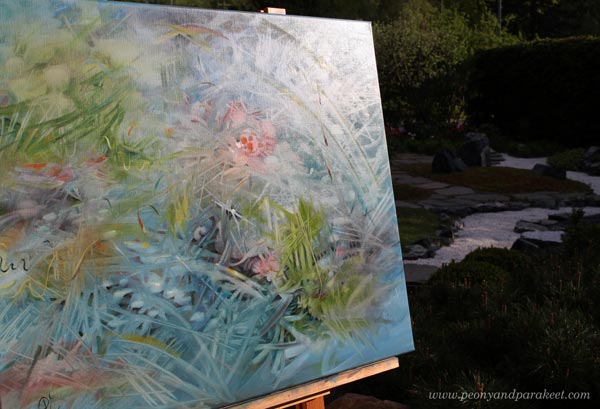
In my classes and in this blog, I talk about old art now and then. But compared to the amount I think about stiff renaissance portraits, romantic baroque sceneries, frilly victorian dresses, cubistic still-lives, and all the masterpieces from the 15th to 20th century, it’s very little.
“My Readers Want Their Art to Be Current”
That’s what I say to myself often. The readers – you – don’t like old art so I try not to write about it. And still, the expected goal to be current seems ridiculous sometimes. There’s a bridge between current and old, and it’s very difficult to be current without knowing what’s not.
That bridge – or should I call it a long historical timeline – is the place where my creativity naturally lies. My shame is also my utmost love. When I paint, I don’t think about Rubens, Monet, Picasso, or Kandinsky. When you love something deeply, with the skills, it comes out naturally.
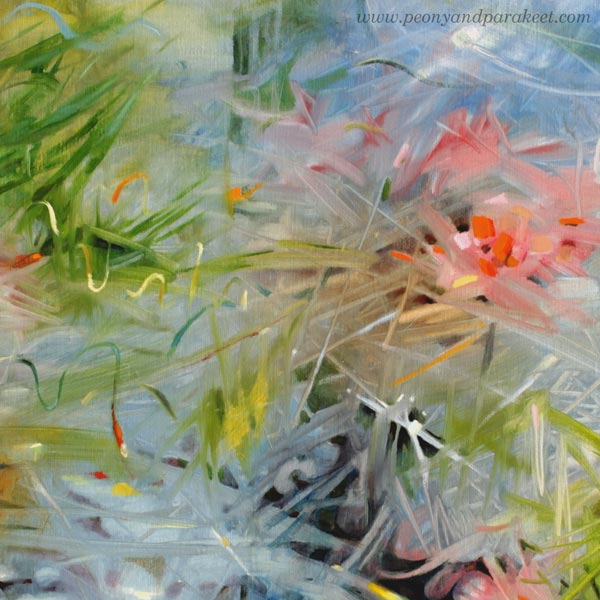
“Everyone discusses my art and pretends to understand, as if it were necessary to understand, when it is simply necessary to love.”
Claude Monet
Monet’s attitude seems very unintellectual. And yet, if you think about what you create and have created, can you relate? That sometimes it’s necessary to omit the feeling of intellectual understanding, bypass the shame, and simply love – so, widen the box instead of trying to get out of it?
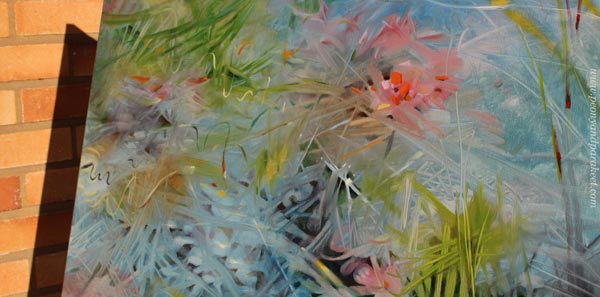
Thumbs up or down for talking about art history and old masters? Share your thoughts in the comments!
P.S. Claude Monet is “a guest teacher” in the class Floral Freedom!

Thumbs up! What were new and exiting ideas and techniques for the Old Masters are not the tried and true basic of much of modern art. I have learned new ways of perceiving modern art but have not lost the old ways, merely blended them.
Your intertwining of images, colours, emotions and philosophy is an art unto itself.
Thanks so much, Jacquelyn, and how beautifully said, thank you.
I really like it when you talk about your understanding of your process, and what it means to you. I’ve studied the old masters and they are not as interesting to me. Love this most recent painting – so free and evocative.
Thank you, Melissa!
Thumbs up Paivi. Your thought process brings new life to the old masters and digs deep so that we as a collective and follower of you, might dig deep especially if we have never studied the old masters. I love all art (mostly) and I love the idea of “its simply necessary to love” a piece. When I see a painting that grabs my attention, I really don’t try to figure it out or try to understand it, I just know I love it.
Thank you, Robin!
Haha, I hate most modern art and definitely prefer the Masters. I don’t find one more intellectual than the other, although classic art may be easier to appreciate at first glance. All kinds of good art move us and make us feel and think.
Thanks, Kat!
I love the old masters. They were men and women, just like we , creatively expressing their experience of life, of what was current, of being human and on the cutting edge of their societies , taking them forward. Artists do this don’t they? Expressing what is hidden, not so readily seen , stretching beyond and often fighting against the respectable, conventional and issues in society.
Shame is about self judgement and interjection. Introjects are those rules and regulations learned in childhood that no longer fit with your emerging truth yet you cling to them because you think your parents, your schooling, your religion and society are correct. These introjects sit in your craw and give you psychological indigestion. You become the protagonist, judge and sentencing jury of your Self! The result is guilt, shame, suppression of your truth and conformity and you suffer because of your self punishment.
There is a big and important difference between Self and self, She and she. One is sacred and true and the other ego which feels inferior and insecure. Ego will either inflate or deflate. Usually the latter in our generation and more often the former in more recent generations.
As artists of course we speak the language of artists past, present and maybe even the guitar. The past language is a rich varied one full of ideas, colour, striving success and struggles. We speak this language, some more fully than others and we create new words, phrases and expressions too.
As to your dear husbands comment . He spoke to what he recognized of Monet’s language. It may have been present or not. You may have been speaking Monet in the early stages of your painting. Even if you were you were still speaking Päivi’s version. What is important is this was your husband’s perception and it speaks to who he is and his reality not necessarily yours. I think this about all criticism or commentary on another’s art. It says more about the critic than the artist for only the artist knows Her own motivation, and creation.
I love your new paintings. I perceive them being full of fast moving organic life and exciting ideas.
I also love your older paintings which seem romantic, imaginative exploring the delight of the child in you and the joy you have in life or so I think!
I think shame and guilt need to be exorcised dear friend. When you peel back the layers of shame and guilt you will find introjects, somebody else’s rules and at the very last layer fear! Fear of not being loved and of being rejected.
I admire your authenticity and desire to expand and express your Self.
Lots of love xxx
Jan.
Thank you for your insights, Jan!
I love this painting – hard to believe it is oil. I’ve grown tired of the Van Goghs, and the Monets. I appreciate the old masters, but I’d rather see something that is not posed, or from a photo, or from plain air sitting. I appreciate the paintings that come from imagination like those of the visionaries, outsider art and naïf painters, and intuitive painters – even the graffiti artists? There are are many “trained “ painters that I love but not the ones who are too precious. Color is what always draws me in.
Than you, Ruth! Oil paintings can be very different, depends on the techniques – thin or thick layers etc.
Please do share – old artist work – new artist work, everything that comes to your mind, I love your post and even if it has changed over the years, I still recognice you in everything you make!
I love to see the old masters work and hear your thoughts about it
And I did’nt think about waterlillies, but i like your colorchoices
Wish you a nice day 🙂
Thank you, Helle!!
Hi Paivi!
This blog is something to make me think this morning.
I think all we experience with all our senses then we gather this into our personal internal library. When we make art and tap into that place where it flows any information in our library can show up. Our work is flavored by our own very unique mixture of experiences.
When I make abstracts and people say they “see things” it used to bother me, but I learned that was their experiences, and way of seeing my work is what spoke, and doesn’t really reflect on my own ideas about my work. Everyone sees and experiences art differently.
As we add to our libraries we move things over and make room for the new. We “outgrow” certain things and learn to love others. If we seek to grow (and not everyone does) we let go of some beliefs and find new ones. Jan describes how that can work very well in her note.
I love what you have painted recently, and it flows naturally from what you painted before. It is very “Paivi”. Yes, because Monet did a million waterlilies paintings ANY loose watery painting with flowers has the possibility of echoing his paintings. Since you did see his work it’s a part of your personal library. So, if you paint something that looks like sunflowers someone might say VanGogh even if you didn’t think of that while creating it. It’s in our collective library now.
I also struggle with wanting to paint something “new”, and not cliche. At this point it seems that anything I do might be similar to one of the millions out there who are creating art. Someone even said there IS NOTHING NEW, which I wonder about.
And new doesn’t always mean it’s any good even if it is very unique…although “good” is based as much on opinion as it is on standards we humans have created to define what is “good”. Obviously there is a lot out there that is not particularly “good”, and there is some amazing great work being done. We are in a time where a huge amount of art is being created by the masses.
I love your painting. It’s lovely and has a lot of organic movement. The muted, but rich colors are beautiful.
Your words are very interesting and give me things to think about.
(BTW; I got that book you mentioned in the other blog and I am a blue.)
Much love, Carla
Thank you, Carla!
These comments are so insightful and there’s so much to read and ponder, thank you so much everyone!!
This is a great post Paivi, because it speaks to me of my own problems and fears with art and indeed, with life. I grew up in a very poor house in an affluent neighbourhood. My parents and I were looked down on by others. My Mom wanted so much to be a part of the upper classes that she found ways to dress me in very extravagant clothes. This backfired, of course, because other girls were jealous. Mom herself, had physical disabilities that left her housebound. Dad was an intellectual and a thespian–he wasn’t interested in “class”. I suffered a lot and felt shame for our my impoverished home and eccentric parents (even though I loved them!). Much later, still living in poverty with my husband and children, I remember my husband, a scholar, saying: “There’s no shame in being poor.”
Jan Illingsworth’s comments on suppression of what “your Truth” is, I find very relevant because of my studies in Jungian psychology. Whatever we suppress becomes the Shadow and will eventually emerge in very unexpected and often, unpleasant ways. Yes, I have much guilt and shame over past deeds and this gets in my way. The “Sacred Self” is often stifled I believe–not only in art, but in life. My attitude toward art has always been one of exploration and although I concentrated on art during my teens, no one except my parents encouraged me. I did not pursue a career in illustration and I have felt a lot shame that I didn’t pursue “my dream”! I’ve always had a fascination with all periods and forms of art, but it wasn’t until my husband died that a search into my own artistic expression really began. Although producing “abstract” has always been difficult–I so often fall back into representation–I’ve followed an eclectic approach, trying everything that is possible whilst living in a small apartment! Recently I’ve wanted to take up fabric art. However, there is often an overwhelming feeling and bewilderment in the art realm–too much online to feel comfortable with!
Paivi, I think your progress in art should only be based on what you feel, not what you “think”. What difference does it make if you follow the old masters or the newer trends , mixing and matching and in the end, simply manifesting your own unique style?! And who knows, perhaps you will in the future create something magnificent blending technology with art–perhaps an architectural achievement! In the words of T.S. Eliot: “We shall not cease from exploration…” I’m convinced of one thing–that art is one of the very best ways to explore ourselves on our spiritual journey. And in summing up, perhaps I am most sympathetic towards that quote by Monet–“It is simply necessary to love”.
Thank you so much for this enlightening post!
Thank you so much for your insightful comment, Lynne! I really enjoyed reading it, it was both interesting and uplifting, thank you!
Shame–it’s a shame we carry that feeling but I think we all do, to a degree; about one thing or another. I agree with a lot of what was written above–to me, art is part of who we are when we paint (or collage or knit or alter books); especially if we can let our self show itself–to show oneself in our art is freeing (I do not–I stay in my head too much). I so enjoy reading what you write and frequently it hits home for me–as does this shame you speak of. I’ve said many times your work is delightful, expressive; full of feelings and life. As far as the old masters go–that style of painting will probably return some day–part of the circle.
Thank you, Helen!!
I love your work Paivi. I love that you talk about the old Masters, and I love when you speak of the modern Masters. I have come full circle in my exploration and appreciation for art, my own attempts included. The thing I deeply admire about all art is the spirit that moves each and every artist to create it. The authenticity, I feel comes from the soul of the artist that creates, because no two are ever alike. Therein lies the uniqueness, their voice, not so much in the subject matter but in the wonderful way they create it and we each perceive it. The way your voice speaks if you are painting dreamy blue fantasy floral scapes, or Finnish folk design, your voice is ever-present. P.S. Love is the only answer *Hugs
Thanks so much for a lovely comment, Michele! Hugs!!